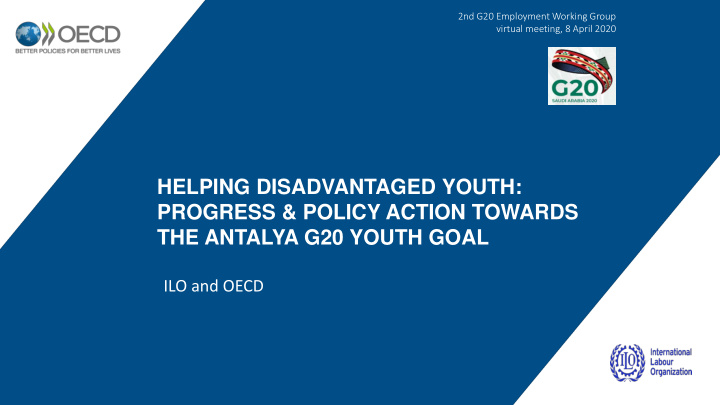



2nd G20 Employment Working Group virtual meeting, 8 April 2020 HELPING DISADVANTAGED YOUTH: PROGRESS & POLICY ACTION TOWARDS THE ANTALYA G20 YOUTH GOAL ILO and OECD
Antalya Youth Target In 2015, G20 Leaders agreed “to reduce the share of young people who are most at risk of being permanently left behind in the labour market by 15% by 2025”. Broad agreement in 1 St EWG meeting to measure progress by: NEET rate: share of young people aged 15 15-29 29 who are Not in Employment, Education or Training Oth ther in indic icators: Covering diverse range of individual and national labour market situations facing disadvantaged youth 2
Most G20 economies have made solid progress towards the Antalya goal 12 countries were ahead of schedule in reaching the Antalya goal Decline in NEET rate, 2014-2019 (% points) Actual decline Expected decline 4.0 2.0 0.0 -2.0 -4.0 -6.0 But COVID-19 risks undoing much of this progress Initial claims for unemployment benefits in the United States 6,000,000 14 April 2007 to 28 March 2020 5,000,000 4,000,000 3,000,000 2,000,000 1,000,000 0 3 04/14/2007 04/12/2008 04/11/2009 04/10/2010 04/09/2011 04/07/2012 04/06/2013 04/05/2014 04/04/2015 04/02/2016 04/01/2017 03/31/2018 03/30/2019 03/28/2020
Going beyond the crisis, structural challenges need to be addressed Much of the decline in the NEET rate driven by declines in unemployed NEETs Change in NEET rate for 15-29 year olds by activity status, 2014-2019 (% points) Unemployed Inactive Total 5.0 3.0 1.0 -1.0 -3.0 -5.0 -7.0 Low-skilled youth face a high risk of labour market exclusion Many young people in unstable and low-paid jobs 4
Young women face additional barriers to good quality jobs NEET rates are higher for young women than for young men NEET rate for 15-29 year olds by gender, 2019 (%) Women Men 60 50 40 30 20 10 0 Greater difficulties in reconciling caring responsibilities with work Narrow stereotypical views about the professional role of young women, and discrimination in employment 5
G20 Policy Principles for Promoting Better Youth Employment Outcomes Improving education and skills of Improving youth employment youth • Ensuring basic skills for all • Strengthening job opportunities • Ensuring school completion • Tackling unemployment • Providing greater choice in • Avoiding prolonged periods out of educational pathways work • Promoting access to higher education • Improving job quality • Bringing closer together the worlds of education and work 6
Sustainable Development Goal 8 Promote sustained, inclusive and sustainable economic growth, full and productive employment and decent work for all Target 8.6: By 2020, substantially reduce the proportion of youth not in employment, education or training Target 8.b: By 2020, develop and operationalize a global strategy for youth employment and implement the Global Jobs Pact of the International Labour Organization 7
Recent developments in national youth employment strategies Mixed interventions Ensuring basic skills for all 11% 7% Promoting better youth employment Improving job quality Ensuring school Improving education and skills 1% completion 8% outcomes Providing greater choice Avoiding prolonged periods out of work in educational pathways 11% 4% Promoting access to higher education Tackling unemployment 25% 4% Strengthening job Bringing closer together the opportunities worlds of education and work 5% 24% 8
Possible elements of a comprehensive Youth Action Plan Strengthen support Improve in economic successful labour downturns market entry • Tackle weak aggregate demand to • Increase quality jobs opportunities avoid large job losses • Better prepare young people for • Extend job retention measures to all school-to-work transition young workers • Promote quality work-based • Expand training opportunities learning and recognition • Strengthen income support for • Promote entrepreneurship young people • Update employment & social legislation for diverse forms of work • Invest in high-quality, cost-effective employment services • Promote engagement in social dialogue 9
Tackle barriers to decent employment for young women Improve Facilitate young educational & Reduce gender women’s access employment disparities in job to the labour choices for girls quality market & young women • Promote participation in • Ensure autonomy in • Promote non- STEM subjects & reproductive decisions discriminatory practices at apprenticeships in all fields • Provide affordable & the workplace • Tackle gender divide in • Reduce gender gaps in quality support for caring digital skills • Invest in care economy & career and pay • Foster leadership skills progression, including after better gender balance in motherhood unpaid work • Promote self-employment • Support job prospects and opportunities mobility through tailored • Promote gender equality in employment services & programmes global and domestic supply chains 10
Recommend
More recommend